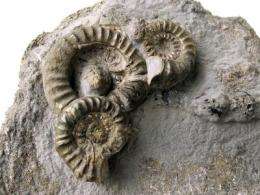First fruitful, then futile: Ammonites or the boon and bane of many offspring

Ammonites changed their reproductive strategy from initially few and large offspring to numerous and small hatchlings. Thanks to their many offspring, they survived three mass extinctions, a research team headed by paleontologists from the University of Zurich has discovered.
For 300 million years, they were the ultimate survivors. They successfully negotiated three mass extinctions, only to die out eventually at the end of the Cretaceous along with the dinosaurs: Ammonoids, or ammonites as they are also known, were marine cephalopods believed to be related to today's squid and nautiloids. Ammonoids changed their reproductive strategy early on in the course of evolution. However, what was once a successful initial strategy may well have proved to be a fatal boomerang at the end of the Cretaceous, as an international team of researchers headed by paleontologists from the University of Zurich demonstrate in a study recently published in the science journal Evolution.
Embryos already had coiled shells
At the beginning of their evolution, ammonoids had straighter shells, which, like other mollusks, they began to coil during the Devonian Period. The precise reason behind this change is unknown. The selection pressure in favor of more tightly coiled shells is believed to have sprung from the ammonoids' natural predators. As the scientists have now discovered, the shell change also affected the ammonoid embryos. "In the oldest ammonoids, the embryonic shells were considerably bigger and coiled less tightly than in later forms," explains Kenneth De Baets, a paleontologist at the University of Zurich, summing up the latest findings.

Smaller hatchlings, more offspring
There were two more evolutionary trends that coincided with the increasingly more tightly coiled shells: The size of the embryonic shells shrank increasingly over time – the hatchlings became smaller and smaller. In parallel, the shell size of fully grown animals increased and, on the whole, the animals became increasingly bigger. Based on this, the researchers deduced that the number of offspring in ammonoids rocketed during the Devonian Period. This is confirmed by discoveries of substantial clusters of fossilized embryonic shells at the end of the Devonian Period and more recent deposits.
"The large number of offspring could have been the key to the rapid proliferation of the ammonoids in the aftermath of each mass extinction," De Baets suspects. His hypothesis is supported by the fact that precisely the groups with smaller, loosely coiled embryonic shells and proportionately fewer offspring died out in certain Devonian extinction events. Nevertheless, the once successful reproductive strategy of many offspring appears to have turned against them at the end of the Cretaceous Period: The ammonoids died out. Only nautiloids have survived until today: They are characterized by large young and a small number of offspring. Exactly how this circumstance had a positive impact upon the survival of the nautiloids is unknown. All that is clear, according to De Baets, is that nautiloids are extremely vulnerable with their reproductive strategy nowadays in view of overfishing.
More information: Kenneth De Baets, Christian Klug, Dieter Korn, Neil H. Landmann. Early evolutionary trends in ammonoid embryonic development. Evolution, International Journal of Organic Evolution. February 14, 2012. doi: 10.1111/j.1558-5646.2011.01567.x
Journal information: Evolution
Provided by University of Zurich




















